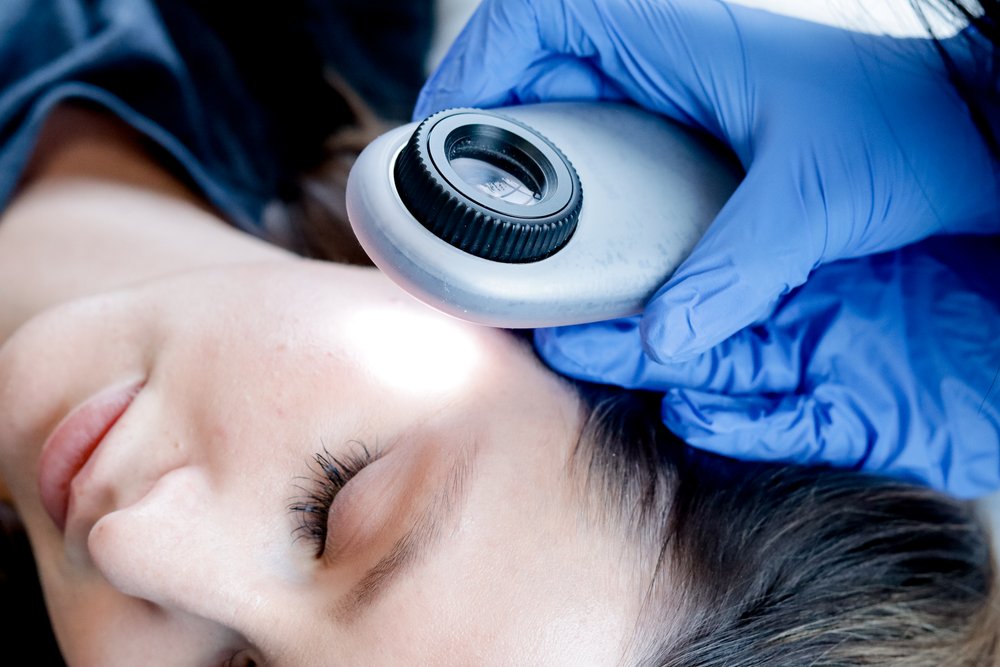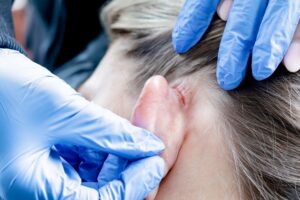
The “C” word. It’s something many of us don’t want to discuss, and none of us want to hear given to us as a diagnosis. Unfortunately, people often take skin cancer a little too lightly – believing it’s not as serious as other forms of cancer. While even the most extreme forms of skin cancer can be successfully treated when caught early, it needs to be taken seriously and addressed properly.
Skin cancer is uncontrolled growth of abnormal cells in the outermost layer of your skin, the epidermis. When DNA is damaged and unable to repair itself, it triggers mutations that lead to rapid multiplication. There are several types of skin cancer, the most notable being basal cell carcinoma, squamous cell carcinoma, melanoma, and Merkel cell carcinoma. Skin cancer can have a variety of causes, and genetics play a role your likelihood. Two of the main causes of most skin cancer are UV rays from the sun or tanning beds.
Basal cell carcinomas are typically on areas with frequent sun exposure such as the face, ears, shoulders, back, neck, and scalp. Intense exposure, such as severe sun or tanning bed burns, as well as long-turn exposure to harmful UV rays are the most common causes of BCCs. This is the most common form of skin cancer and is typically just locally destructive but can occasionally metastasize and is rarely fatal. If detected and treated early, it causes minimal issues.
These will frequently appear as:
- An open sore that doesn’t heal
- Shiny, skin-colored bumps or nodules
- A waxy scar-like spot
- Small, pink, slightly rough growths
- Reddish, irritated patches that don’t go away.
- Open sores that don’t heal or reappear.
Squamous cell carcinomas arise (unsurprisingly) from the squamous cells in the epidermis layer. These are thin, flat cells, not dissimilar to fish scales in appearance. They are also found in the hollow organs and the lining of the respiratory and digestive tracts. These are often found in areas that will show more signs of sun damage, such as age spots and wrinkles, like the face, ears, scalp, and hands. Squamous cell carcinomas are the second most common form of skin cancer diagnosed in the US each year and are more likely than BCCs to metastasize with rapid growth if not detected early.
These will frequently appear as:
- Thick, rough scaly patches – may crust or bleed.
- Open sores that don’t completely heal
- Wart-like bumps
- Growths with raised edges and lowered center spots
- An irregular spot that may be surrounded by visible signs of sun damage.

Melanomas are cancers that form from melanocytes. These cells produce melanin pigment, which is what gives our skin its color. These are likely the type of skin cancer that you’ve heard of the most, and that you associate with moles. Melanomas are most commonly caused by intense, intermittent exposure to harmful UV rays such as regular tanning bed use or frequent sunburns. This is the most dangerous of the three most typical forms of skin cancer, but because of evolving medicine, knowledge, and technology, it is often curable when caught and treated in its early stages. If undetected or left untreated, melanoma can become invasive and metastasize leading to extensive tissue damage or death. These often appear on legs of women and on the trunks of men, but can arise anywhere on the body, even places that haven’t seen frequent sun exposure. It’s helpful to remember the ABCDEs when it comes to melanoma.
Look for ABCDEs and Ugly Ducklings:
- Asymmetry – Look for spots and lesions where two halves don’t match if you were to draw a line down the middle.
- Border – Melanoma borders will typically be uneven and have notched edges.
- Color – Multiple colors within one mole is a warning sign for atypical cells and melanoma. It may have various shades of brown, tan and black as well as white, red, or even blue spots.
- Diameter / Darkness – If a spot or mole is larger than the size of a pencil eraser, it is important to have it checked. While some people have perfectly healthy large moles, this could be a sign of rapid abnormal cell growth. It’s also important to have any spot that’s particularly dark, compared to the rest of your moles and freckles, checked by a dermatologist…regardless of size.
- Evolving – Be on the lookout for any changes in shape, color, size, or elevation of spots on your skin. It is helpful to have a consistent awareness of your skin so you can self-monitor for any new or changing spots, or new symptoms.
- Ugly Duckling – As stated previously, it’s important to monitor your skin for any spots that look particularly different than the moles and freckles in the same area, or a mole/lesion that arises in an area where you don’t have any other moles or freckles.

Keep in mind that not all melanomas will follow these typical appearance patterns and can come in many forms. Some rare melanomas, known as amelanotic melanomas, are colorless or the same color as the rest of your skin. This makes them particularly difficult to recognize to an untrained eye. Some melanomas can even be found between fingers and toes or on the palms of your hands and feet. This is why it’s so important to get any questionable spots evaluated, and schedule annual skin exams with your dermatologists.
Merkel cell carcinoma is a very aggressive, but rare form of skin cancer. Typically, these will appear on the head or neck, and sometimes on the eyelids. While these often arise due to areas being excessively exposed to the sun, especially on fair, aged skin, it is usually associated with the Merkel cell polyomavirus. These are most common if you are over the age of 50 or immunocompromised. Lesions will typically expand rapidly and is often asymptomatic (painless). Diagnosis is difficult, and if diagnosis or treatment are delayed the risk of recurrence and metastasis grows quickly.
If your dermatologist discovers a questionable spot, they will typically go ahead and biopsy the area that same day and send it off to dermapathology. If the results come back abnormal or cancerous, your provider will work with you on a treatment plan.
Some early cancers can be treated with cryosurgery (freezing). Liquid nitrogen is applied directly to the area of concern, typically with a special spray device. This freezes the tissue and kills the cells in the area, most importantly the abnormal or cancerous cells. There is a small chance the skin cancer could return after these treatments.
Excisional surgery can be an adequate option for many types of skin cancer. Your physician will cut out and remove the cancerous tissues as well as some of the surrounding healthy skin to ensure all abnormal cells are retrieved. The excised tissue will be sent to the pathologist for testing.
Mohs surgery is often performed for recurring, large, or difficult skin cancers such as some basal and squamous cell carcinomas or in areas where it’s crucial to preserve as much healthy skin as possible. The skin growth is removed one layer at a time, and each layer is examined on a microscopic level. Once no abnormal cells are noted, the physician can finish the procedure.
Electrodesiccation, radiation therapy, chemotherapy, biotherapies, and certain phototherapies are other treatments that may be used for difficult, aggressive, or more advanced skin cancers.
The BEST way to protect yourself from any form of skin cancer is to avoid unprotected UV exposure! Tanning beds are highly discouraged. Protective clothing, shade where it is accessible, hats, UV-blocking sunglasses, and broad-spectrum sunscreen are some of your best defenses when outside enjoying the sunshine. You should absolutely be wearing sunscreen every single day, even when its cloudy, raining, or you plan to spend the day inside.
Our board-certified dermatologist, Dr. Erin Ducharme, will evaluate your skin, remove any suspicious spots, and make sure they are properly analyzed so you can have peace of mind or receive prompt treatment! With a passion for our patients, the team at Ducharme Dermatology will help you feel comfortable, confident, and informed during your appointment and in any treatments you receive. Don’t take chances when it comes to the health of your skin. Contact us today to schedule your skin cancer screening today!

